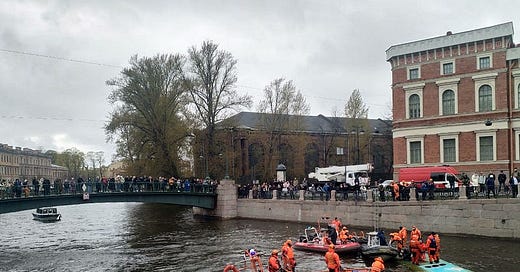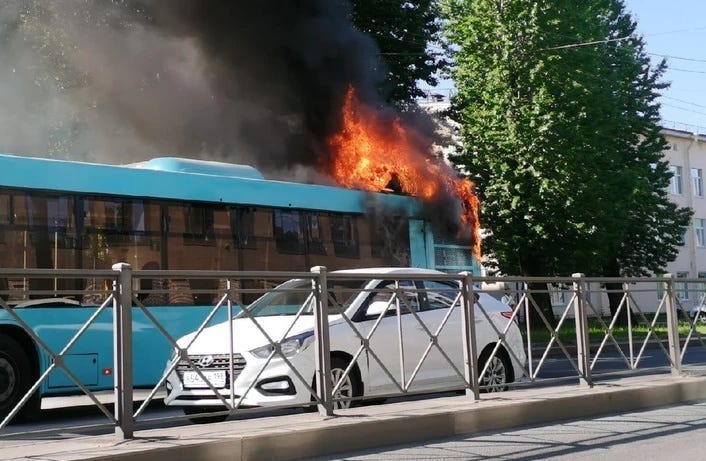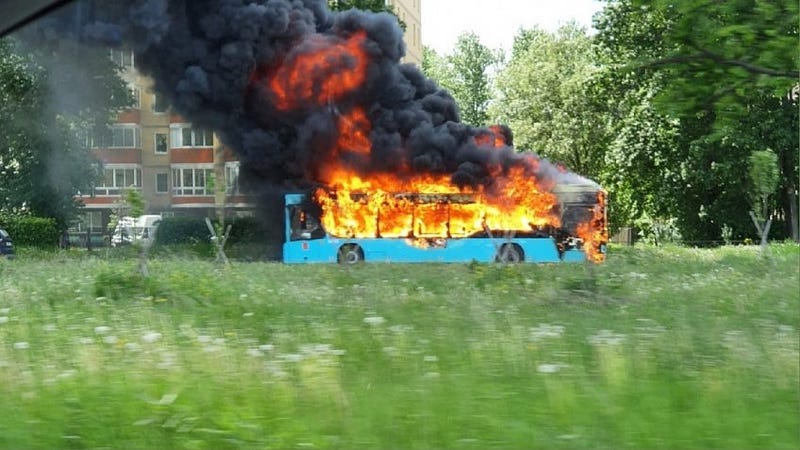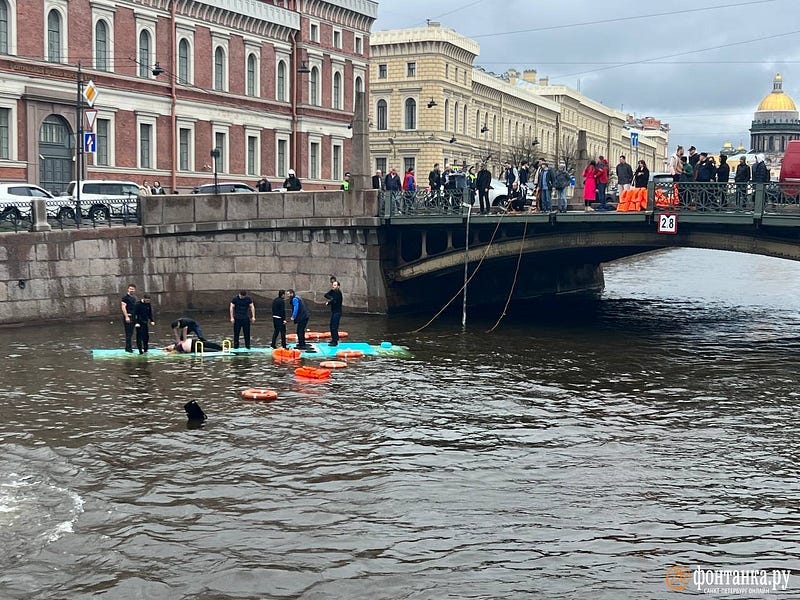Russia In All Its Glory Sends a Bus into an Icy River Filled with Passengers
In the center of St. Petersburg, a city bus flies into the river, killing 7.
A city bus, one of the infamous “light blue” ones (more about what makes them so talked about later), was driving along the lovely and nearly empty Kryukov Embankment in the heart of St. Petersburg’s beautiful city center. On the bus’s left was a naval museum and administration building, and to the right, the architecturally famous “New Holland,” first built over 300 years ago. It is now a park and cultural center (and where I used to ice skate on lovely, wintry mornings between 2013 and 2022).
Inside Bus 229, a middle-aged, well-dressed woman sat in deep thought in the front seat. Across the aisle, an attentive driver steered the bus with calm precision. The video footage from inside the bus revealed a typical driving routine: scanning the road ahead, checking the mirrors, and maintaining a steady pace. Contrary to some reports, he was not asleep or chatting with anyone on his cell phone. The passengers we can see, three of the 16 on the bus, are all sitting calmly, enjoying the ride, which tells us that there was nothing out of the ordinary about the trip.
As the bus approached the end of the street, which curves first left. Then, after about 70 feet sharply to the right, sending the road across a bridge that has for well over a century been mistaken as “the kissing bridge” (couples, including me in 2009, flock to it to have their photos taken kissing loved ones), the driver can be seen suddenly struggling to turn the bus, almost as if it was a bucking young bronco. Shifting to an outside view of the bus, we see it hit a high curb that protects the sidewalk on the embankment and careens off of it.
The driver has managed to steer the bus to the left as he tries to guide it onto the “kissing bridge,” but then it hits one of two massive historical anchors lying on the sidewalk and bounces off them. He has now managed to turn the wild, rampaging buck hard to the right and back onto the bridge, where he proceeds to hit two passing cars, which had both stopped when they saw the runaway bus.
Plowing past those cars, the bus, still not having been brought to anything that would resemble a stop or an attempt to stop, jumps the high curb, rips through the historic and intricately-designed guard rails on the bridge, and falls into the Moika River — famous for slow-moving boats filled with tourists and not far from where Rasputin was murdered (and my cafe known as “The Brooklyn Bridge” was in 1997–98).
Within seconds after the bus hit the water, the sky-blue bus was completely underwater except for the very top. One of the few survivors not in a coma told reporters that when the bus hit the water, there was a second or two when the water was only ankle deep, and the passengers began moving to figure out how to escape. 10 seconds later, the bus was filled to the roof with black, icy water, and he struggled to get a final breath before going under. Before heroic passersby pulled him out, the survivor frantically tried to find his wife under the water. He didn’t find her, and she was pulled out dead later.
The Light Blue Buses
Shortly after the war started in 2022, the mayor of St. Petersburg, Alexander Beglov, a Kremlin-appointee from Moscow, introduced what became known as the “mass transit reforms.” As part of these so-called reforms, a fleet of Robin’s Egg Blue buses was introduced into the city. Almost immediately, problems with the buses began to terrorize local residents.
In two years, over 20 of these buses have burst into flames. Fortunately, no one had died, but people have been injured in the panic to get out of them. The city of St. Petersburg has made no complaints to the manufacturer because the buses come from Belarus. The large order was part of the “payment” Russia was making to the Belarussian dictator, Alexander Lukashenko, to win his full support for Russia’s illegal invasion of Ukraine.
Given the way things work in Russia, there could be no way that such a decision as replacing roughly 35 percent of the city’s public transit system with new buses could ever happen without the well-greased hand of the city’s mayor — who in Russia is called a “governor” due to the city’s size making St. Petersburg its own region. Even the hardcore Putinists suspect that St. Pete’s governor made millions of dollars on the deal, and that is why not one official action has been taken against the bus manufacturer.
Within moments of the latest incident with a blue bus, unofficial reports filled the virtual world in Russia that the non-Russian driver, a legal immigrant from Tajikistan, was guilty. After it was learned he had survived, the police detained him, and a criminal investigation was opened, which means in Russia that he is already guilty.
There is a chance he was speeding and lost control, but as the video shows from inside the bus, the situation seemed completely calm and normal. It is a fairly sharp turn, and it appears that the driver couldn’t slow the bus down, suggesting brake problems. In Russia, though, protecting thieving, corrupt government officials is a religion, and when the fall guy happens to be a non-Russian, fabricating evidence to protect the powers-that-be is a no-brainer.
This is how Russia exists from year to year. This is why Russia has proven, thankfully, so incompetent at waging its war in Ukraine. This is why Russia, generation after generation, always reverts to the leadership of destructive, cowardly psychopaths like Vladimir Putin. This is why most Russians treat non-family members — and quite often even family members — so notoriously poorly.
Everyone knows deep down that regardless of what happens, someone higher up will be protected; it is also why of all the passersby jumping into the water to save the passengers, four were from Tajikistan and two from Kyrgyzstan. One Russian boy, 19, also jumped in. The boy was too young to “know any better,” which means that unsolicited heroism in Russia can be a reason to be punished. The non-Russians just demonstrated how healthy and humane their societies are despite despotic leaders.
Ugly Russia
After I wrote the sentiments above, Russia reared its ugly head and proved me right earlier today. An article appeared online in St. Petersburg, casting doubt on the heroism of the six non-Russian passersby. Despite that, the whole world could see them selflessly diving into the ice-cold water and climbing onto the roof of the submerged bus to free the trapped passengers, lazy-good-for-nothing official Russian used the power it had in with the state media to suggest that those “heroes” actually saved no one and just prevented the first-responders from doing their jobs, which may have resulted in more deaths.
Here, we can see the young men pulling passengers out. The city authorities need to show the Russian people that everything is okay. The accident happened because of a negligent non-Russian driver, and Russia’s hero first responders did their job. This photo was taken 10 minutes after the bus entered the water; no first responders were on the scene.
Commenters to the report that these young men interfered with said they acted that way, hoping they would get citizenship or monetary rewards. As I have said for decades, and this once again proves me correct, Russians cannot conceive of selfless acts done because of a sense of responsibility for our fellow humans. The vast majority will calculate, “What in it for me?” This is not because they are inherently evil, though; it’s because the Russian system punishes them for being kind and good — “Who asked you to jump in the water?”
One Russian man, the first on the scene, asked by a reporter why he didn’t jump in to save anyone, said calmly, “I didn’t want to get in the way. It’s not my job anyway.”







